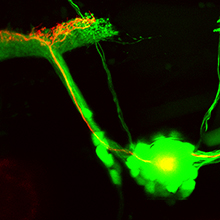Bright prospects: Repairing Neurons with light

Zebrafish neurons projecting to the brain (green). One neuron expresses a light-activatable enzyme (red). Scientist were able to stimulate the regeneration of injured neurons using optogenetics. Source: Helmholtz Zentrum München (HMGU)
The nervous system is built to last a lifetime, but diverse diseases or environmental insults can overpower the capacity of neurons to maintain function or to repair after trauma.
A team led by Dr. Hernán López-Schier, head of the Research Unit Sensory Biology and Organogenesis at Helmholtz Zentrum München, now succeeded in promoting the repair of an injured neural circuit in zebrafish.
Key for the researchers’ success was the messenger molecule cAMP, which is produced by an enzyme called adenylyl cyclase. For their experiment, the scientist used a special form of this enzyme which is inducible by blue light. Therefore, the scientists are able to specifically modulate the production of cAMP in cells expressing this enzyme by the use of blue light.*
The researchers used this system in zebrafish larvae** which had interrupted sensory lateralis nerves***. “However, when blue light was shone on severed nerves that expressed a photoactivatable adenylyl cyclase, their repair was dramatically increased,” remembers PhD student Yan Xiao who is the first author of the study.
“While untreated nerve terminals only made synapses again in five percent of the cases, about 30% did after photostimulation.” In simple terms: the scientists were able to stimulate the repair of a neuronal circuit by elevating cAMP with blue light.
“Optogenetics have revolutionized neurobiology, since the method has already been used to modify for instance the electrical activity of neurons. However, our results show for the first time how the repair of a complex neural circuit in a whole animal can be promoted remotely by the use of light”, explains López-Schier.
But the head of the study thinks that this is only the beginning: “Our results are a first step. Now we would like to investigate, whether these results can be extrapolated beyond single neurons in zebrafish, to more complex neuronal circuits of higher animals.” The scientist could think of using this method for future therapeutic approaches for the treatment of neuropathies like those occurring in the wake of Diabetes and other diseases.
Further information
Background
* Optogenetics: As the name indicates, this cutting-edge technology combines elements of Optics and Genetics. Scientists make use of proteins which are sensitive to certain wavelengths of light. These are brought into the target cells with certain genetic methods. The so treated cells then change their respective phenotype depending on the exposure to light.
** Larvae of zebrafish are particularly well suited for optogenetic approaches, since their skin in transparent/translucent. Thus, the light can reach the respective target cells easily.
*** These nerves normally communicate external sensory signals to the brain, but cannot normally repair after injury.
Original publication:
Xiao, Y. et al. (2015). Optogenetic stimulation of neuronal repair, Current Biology, DOI: 10.1016/j.cub.2015.09.038
Link to the publication
http://www.cell.com/current-biology/abstract/S0960-9822(15)01149-5
As German Research Center for Environmental Health, Helmholtz Zentrum München pursues the goal of developing personalized medical approaches for the prevention and therapy of major common diseases such as diabetes mellitus and lung diseases. To achieve this, it investigates the interaction of genetics, environmental factors and lifestyle. The Helmholtz Zentrum München has about 2,300 staff members and is headquartered in Neuherberg in the north of Munich. Helmholtz Zentrum München is a member of the Helmholtz Association, a community of 18 scientific-technical and medical-biological research centers with a total of about 37,000 staff members.http://www.helmholtz-muenchen.de/en/index.html
The independent Sensory Biology and Organogenesis (SBO) research unit works with a zebra fish model system to examine cellular, molecular and physiological reactions to mechanical stimuli and sensory disorders. The focus areas are physical and mechanical tissue properties. The objectives are to examine the mechanisms that control sensory system development, self-regulation and regeneration and to research the evolution of the sensory organs that perceive the environment. http://www.helmholtz-muenchen.de/en/sbo/index.html
Contact for the media:
Department of Communication, Helmholtz Zentrum München – German Research Center for Environmental Health (GmbH), Ingolstädter Landstr. 1, 85764 Neuherberg – Phone: +49 89 3187 2238 – Fax: +49 89 3187 3324 – E-mail: presse@helmholtz-muenchen.de
Scientific contact at Helmholtz Zentrum München:
Dr. Hernán López-Schier, Helmholtz Zentrum München – German Research Center for Environmental Health (GmbH), Research Unit Sensory Biology and Organogenesis, Ingolstädter Landstr. 1, 85764 Neuherberg – Phone: +49 89 3187 2187 – E-mail: hernan.lopez-schier@helmholtz-muenchen.de
Media Contact
All latest news from the category: Life Sciences and Chemistry
Articles and reports from the Life Sciences and chemistry area deal with applied and basic research into modern biology, chemistry and human medicine.
Valuable information can be found on a range of life sciences fields including bacteriology, biochemistry, bionics, bioinformatics, biophysics, biotechnology, genetics, geobotany, human biology, marine biology, microbiology, molecular biology, cellular biology, zoology, bioinorganic chemistry, microchemistry and environmental chemistry.
Newest articles

Silicon Carbide Innovation Alliance to drive industrial-scale semiconductor work
Known for its ability to withstand extreme environments and high voltages, silicon carbide (SiC) is a semiconducting material made up of silicon and carbon atoms arranged into crystals that is…

New SPECT/CT technique shows impressive biomarker identification
…offers increased access for prostate cancer patients. A novel SPECT/CT acquisition method can accurately detect radiopharmaceutical biodistribution in a convenient manner for prostate cancer patients, opening the door for more…

How 3D printers can give robots a soft touch
Soft skin coverings and touch sensors have emerged as a promising feature for robots that are both safer and more intuitive for human interaction, but they are expensive and difficult…





















